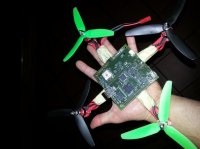Hi guys,
I'm opening this new thread to speak about the hardware to be used with the BeagleDrone.
If we speak about the BBB usage, from my perspective there're two main approaches:
Bests,
Victor.
I'm opening this new thread to speak about the hardware to be used with the BeagleDrone.
If we speak about the BBB usage, from my perspective there're two main approaches:
- Integrated one: Erle Robot is a low cost, light-weight and fully integrated Linux drone (BB-based) with all the necessary sensors and peripherals to perform simple missions. It includes 3 accelerometers, 3 magnetometers, 3 gyroscopes, 2 range finders (bottom and top), altimeter, GPS and a big quantity of IOs to hack it. Please refer to the web for more information.
View attachment 16313
I honestly believe that LinuxDrone can be a great asset these kind of drones. Furthermore the robot Erle's design is still open so we would be happy to integrate all the feedback/request that you guys might have. - Using capes: The most representative example of this approach is the PixHawk Fire Cape announced by the ArduPilot guys. They've promised many sensors on board and they aim to improve the ARDrone stability system.
Bests,
Victor.

